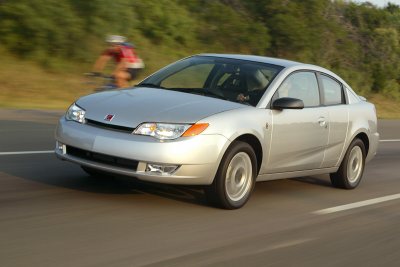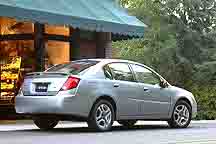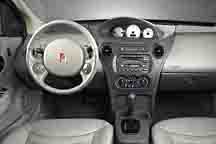
Base MSRP Range:
- Sedan, Ion 1, manual - $11,500, automatic - $12,500
- Sedan, Ion 2, manual - $13,500, automatic - $14,500
- Sedan, Ion 3, manual - $15,000, automatic - $16,000
- Coupe, Ion 2, manual - $14,000, automatic - $15,000
- Coupe, Ion 3, manual - $15,500, automatic - $16,500
Base Invoice Range:
- Sedan, Ion 1, manual - $10,500, automatic - $11,500
- Sedan, Ion 2, manual - $12,500, automatic - $13,500
- Sedan, Ion 3, manual - $14,000, automatic - $15,000
- Coupe, Ion 2, manual - $13,000, automatic - $14,000
- Coupe, Ion 3, manual - $14,500, automatic - $15,000
MSRP As Tested: $15,990
Versions: Sedan: Ion 1, Ion 2, Ion 3. Quad Coupe (2-full-size doors and 2-partial doors): Ion 2, Ion 3.
Vehicle Category: Compact four-door sedan, Quad coupe with 2-full doors and 2-partials.
Engine Location: Front Engine
Drive Wheels: Front-Wheel Drive
Engine As Tested: 2.2-liter, Dual Overhead Cam, Inline-4 cylinder, 140-horsepower at 5,800 rpm and 145 lb-ft torque at 4,400 rpm.
Transmission As Tested: Sedan - 5-Speed Manual or optional 5-Speed Automatic. Coupe - 5-Speed Manual or optional Continuously Variable Automatic Transmission.
Fuel Economy (city/hwy): 5-Speed Manual - 26/33. 5-Speed Automatic - 24/32.
Standard Safety Features: Driver and front passenger airbags, 2-wheel disc and 2-wheel drum brakes, In-Trunk Emergency Trunk Release, Daytime Running Lights.
Competition: Sedans - Chevrolet Cavalier, Dodge Neon, Ford Focus, Honda Civic, Hyundai Accent, Hyundai Elantra, Kia Rio, Kia Spectra, Mazda Protege, Mitsubishi Lancer, Nissan Sentra, Suzuki Aerio, Toyota Corolla, Toyota ECHO, Volkswagen Golf, Volkswagen Jetta. Sedans -Chevrolet Cavalier, Ford Escort, Ford Focus, Honda Civic, Honda Insight, Hyundai Accent, Hyundai Elantra, Kia Spectra, MINI Cooper, Pontiac Sunfire, Toyota ECHO, Volkswagen Golf, Volkswagen New Beetle,

SAN MARCOS, Texas -- Steering a curvy two-tone issue of the Ion through campus at Southwest State Texas University in San Marcos, we observe that the eyes of so many students strolling along Lyndon Baines Johnson Boulevard seem to be following Saturn's new compact-class sedan as we drive by.
The crisp and edgy styling of Ion commands attention, of course, due to some strong geometric shapes mingled with angular flanks and a bold but squared tail counterbalanced by smooth rails extending over the arched cab.
Our particular vehicle also carries other distinctions with the curvaceous roof rails tinted in a shade of blue contrasting against the silver body color. These interchangeable plastic panels can be installed as trim accents from a do-it-yourself kit that's color-coordinated with trim pieces for the cabin, such as bezels ringing the instrument panel, shifter stick and climate control panel.
The two-tone treatment looks sporty and quite different from the usual -- and usually ho-hum -- small car.
Ion also carries hallmarks of a pricy vehicle, so many different surface angles blending into a homogeneous whole plus the tail design that evokes images remindful of Cadillac's CTS sports sedan, yet this innovative car designated to replace Saturn's compact S-Class staple comes to market with competitive and affordable price points.
Ion 1, the entry issue with a sophisticated four-cylinder powertrain and German-built manual transmission plus 14-inch wheels and tires, lists for $11,995, including a $485 freight fee. Add a high-tech five-speed automatic transmission and the figure still looks good at $12,895.
Ion 2, gaining power door locks, air conditioning and a stereo audio system with CD deck, rolls on 15-inch wheels and tallies to $13,995 with the manual stick and $14,895 with the automatic.
Ion 3, the deluxe version with more equipment including power windows and larger 16-inch alloy wheels, comes to $15,495 for the manual and $16,395 with auto shifting.
Besides styling for a four-door sedan, the Ion name also applies to a clever sports coupe rigged with two concealed rear doors.

In variation from the typical two-door coupe, Saturn's design sets these extra doors immediately behind the front doors. Hinged at the rear with handle tucked flush into the leading edge of the jam, each rear door swings wide and permits easier access to rear seats.
To open the back door first requires opening the front door, and the rear panel then swings wide at right angle to create a broad and pillar-less portal on each side.
Saturn labels this design for Ion the Quad Coupe.
In the cabin, the back of the front passenger bucket folds forward to form a flat horizontal surface, and backs of the rear seats, divided into two separate sections, also fold flat on the same plane as the floor of the tail-side cargo compartment.
Long cargo items like lumber or sports gear such as skis or even a plastic kayak can be stacked on top of these folded seats and extended from dashboard to tail door.
Foundation for both sedan and Quad Coupe designs of Ion is the new Delta global small-car architecture from General Motors destined for multiple applications among GM brands.
It's a world-class platform, strong and stiff to support high-tech components including an electronic power steering (EPS) system for the rack and pinion mechanism. With speed-sensitive power boost for turning, the system eliminates the need for a power steering pump.
Suspension design, consisting of independent front elements with semi-independent torsion beams in back, also shows stabilizer bars fore and aft. Components remain constant for all trims, with tuning accomplished by increasing the tire size.
Compared against Saturn's original S-Class cars, these new models show a longer wheelbase and wider track. In addition, the resultant body is several inches taller and six inches longer than predecessors.
Still, they remain consistent with Saturn's hallmarks, such as body panels constructed from molded polymer. The pliable plastic resembles sheetmetal but flexes in the face of parking-lot mishaps like encounters with other car doors or grocery carts. Following a cart collision, it snaps back to the original shape leaving no dent or ding -- and no chipped paint.
Significant safety content, another tradition for Saturn's vehicles, originates with the structural design that incorporates crush zones front and rear to absorb energy forces from a collision and deflect them from the safety cage surrounding the passenger compartment.
Frontal air bags for driver and passenger are aboard, and side curtain-style air bags concealed in roof rails above front and rear doors are available as a stand-alone option priced at $395.
All models draw from GM's EcoTec four-pack engine.
This modern plant -- a dual-cam design displacing 2.2 liters and mustering a hardy 140-hp at 5,800 rpm plus 145 lb-ft of torque at 4,400 rpm -- was developed as a universal engine for service in various brands of General Motors.
It also shows up in Saturn's L-Series sedans and station wagons plus the Vue sport-utility wagon.
Standard transmission is a manual five-speed by Germany's Getrag. It's tight and controllable with a short-throw stick.
Optional for the sedan is a smooth-shifting new five-speed automatic.
Ion Quad Coupe takes a different tact by adding an optional continuously variable transmission (CVT). Rather than the traditional step-ratio gears of a conventional automatic, this transmission uses pulleys and a special steel belt to precisely match engine output to vehicle speed, enabling seamless acceleration through all speeds.
The device approaches a manual shifter's fuel economy but delivers virtually undetectable shift transitions.
Design of the cabin for both sedan and coupe also varies from the norm by boosting all seats to elevated positions for easier access and better visibility.
Also, the instrument cluster mounts at the top center of the dashboard, leaving the area immediately in front of Ion's small and sporty steering wheel airy and uncluttered.
Driving Ion is easy, even fun, for coupe or sedan.
It's stable and quiet at speed on a freeway, as we discover in a run down I-35 from Austin to San Marcos. On a curvy circuit, like our route around Texas Hill Country through Blanco and Dripping Springs, it feels solid and composed in flat stance with little body roll evident.
Editors' Ratings
Pros: Great cargo capacity. Partial doors on the Coupe makes rear access much easier than competitors.
Cons: Stodgy and uninspiring design inside and out. Poor build quality. Cheap plastic parts on the interior -- some falling off of brand new vehicles. Noisey when idling and driving. Many better products from other competitors.
Ratings (1-10)
- Style: 2
- Performance: 4
- Price: 3
- Handling: 5
- Ride: 5
- Comfort: 4
- Quality: 2
- Overall: 3.6
More Data
Where Built: USA
Major Options: Antilock Braking System, Traction Control, Front and Rear Side Airbags.
Seating: 5
Number of Rows: 2
Crash Test Ratings:
- NHTSA Frontal Impact/Driver Crash Test Rating: Not Yet Tested
- NHTSA Frontal Impact/Passenger Crash Test Rating: Not Yet Tested
- NHTSA Side Impact/Front Seat Crash Test Rating: Not Yet Tested
- NHTSA Side Impact/Rear Seat Crash Test Rating: Not Yet Tested
- NHTSA Rollover Resistance Rating: Not Yet Tested
- IIHS Frontal Offset Crash Test: Not Yet Tested
Length in Inches: Sedan - 184.5. Coupe - 185.0.
Warranties: 3 years/36,000 miles bumper-to-bumper, 6 years/100,000 miles corrosion, 3 years/36,000 miles free Roadside Assistance.
Weight in Pounds: Sedan - 2,692. Coupe - 2,751.
Towing Capacity in Pounds: Not Applicable
Gas Tank Capacity in Gallons: 13.5
Destination Charge: $485




